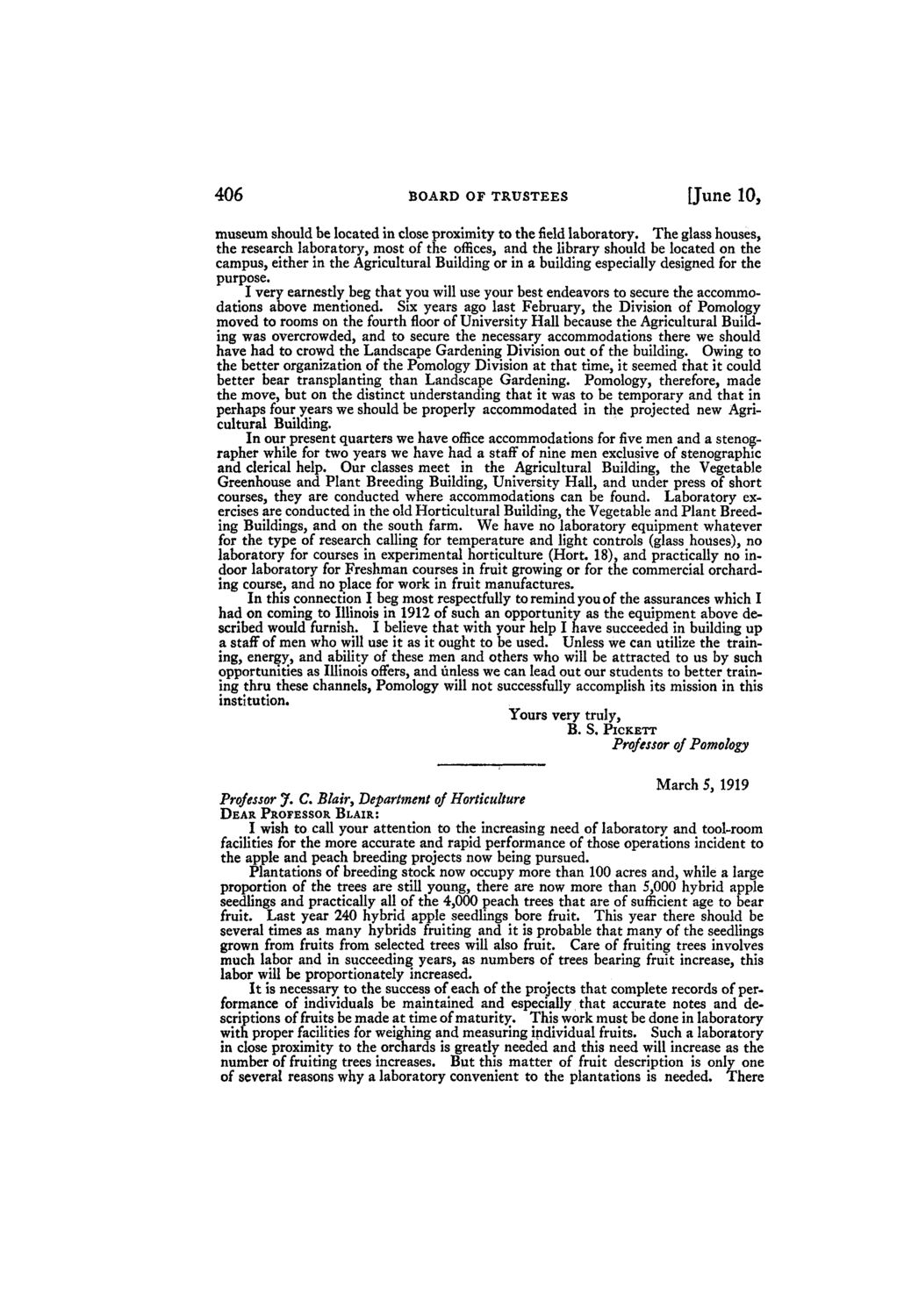| |
| |
Caption: Board of Trustees Minutes - 1920
This is a reduced-resolution page image for fast online browsing.

EXTRACTED TEXT FROM PAGE:
406 BOARD OF TRUSTEES [June 10, museum should be located in close proximity to the field laboratory. The glass houses, the research laboratory, most of the offices, and the library should be located on the campus, either in the Agricultural Building or in a building especially designed for the purpose. I very earnestly beg that you will use your best endeavors to secure the accommodations above mentioned. Six years ago last February, the Division of Pomology moved to rooms on the fourth floor of University Hall because the Agricultural Building was overcrowded, and to secure the necessary accommodations there we should have had to crowd the Landscape Gardening Division out of the building. Owing to the better organization of the Pomology Division at that time, it seemed that it could better bear transplanting^ than Landscape Gardening. Pomology, therefore, made the move, but on the distinct understanding that it was to be temporary and that in perhaps four years we should be properly accommodated in the projected new Agricultural Building. In our present quarters we have office accommodations for five men and a stenographer while for two years we have had a staff of nine men exclusive of stenographic and clerical help. Our classes meet in the Agricultural Building, the Vegetable Greenhouse and Plant Breeding Building, University Hall, and under press of short courses, they are conducted where accommodations can be found. Laboratory exercises are conducted in the old Horticultural Building, the Vegetable and Plant Breeding Buildings, and on the south farm. We have no laboratory equipment whatever for the type of research calling for temperature and light controls (glass houses), no laboratory for courses in experimental horticulture (Hort. 18), and practically no indoor laboratory for Freshman courses in fruit growing or for the commercial orcharding course, and no place for work in fruit manufactures. In this connection I beg most respectfully to remind you of the assurances which I had on coming to Illinois in 1912 of such an opportunity as the equipment above described would furnish. I believe that with your help I have succeeded in building up a staff of men who will use it as it ought to be used. Unless we can utilize the training, energy, and ability of these men and others who will be attracted to us by such opportunities as Illinois offers, and unless we can lead out our students to better training thru these channels, Pomology will not successfully accomplish its mission in this institution. Yours very truly, B. S. PICKETT Professor of Pomology March 5, 1919 Professor J. C. Blair•, Department of Horticulture DEAR PROFESSOR BLAIR: I wish to call your attention to the increasing need of laboratory and tool-room facilities for the more accurate and rapid performance of those operations incident to the apple and peach breeding projects now being pursued. Plantations of breeding stock now occupy more than 100 acres and, while a large proportion of the trees are still young, there are now more than 5,000 hybrid apple seedlings and practically all of the 4,000 peach trees that are of sufficient age to bear fruit. Last year 240 hybrid apple seedlings bore fruit. This year there should be several times as many hybrids fruiting and it is probable that many of the seedlings grown from fruits from selected trees will also fruit. Care of fruiting trees involves much labor and in succeeding; years, as numbers of trees bearing fruit increase, this labor will be proportionately increased. It is necessary^ to the success of each of the projects that complete records of performance of individuals be maintained and especially that accurate notes and descriptions of fruits be made at time of maturity^ This work must be done in laboratory with proper facilities for weighing and measuring individual fruits. Such a laboratory in close proximity to the orchards is greatly needed and this need will increase as the number of fruiting trees increases. But this matter of fruit description is only one of several reasons why a laboratory convenient to the plantations is needed. There
| |